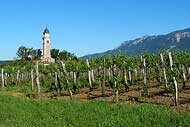
Vineyard in the Vipava Valley, Slovenia
Slovenia, which has a rich wine heritage and centuries of winemaking traditions is just emerging on the international wine scene, having modernised its vineyards and improved its winemaking practices. It is a small country (only about 300 kilometers across) with a diverse geography, a wide variety of climates, and three main wine producing regions. Primorje, derived from the Slovene by the sea, is Slovenia's most widely known wine region. It borders Italy's Friuli-Venezia-Giulia with a small part being actually on the Adriatic coast. The region enjoys a Mediterranean climate with warm summers. Posavje or the valley of the Sava River is closer to the Croatian border and has a continental climate. Podravje or the valley of the Drava river is Slovenia's largest wine-growing region. It is located on the northeastern corner of Slovenia, bordering Austria, Hungary, and Croatia, With a mixed Alpine-continental climate, the region's wine production is mostly white.

Slovenia's wine growing regions
The tasting was at the CAV Wine Bar & Kitchen in San Francisco, a warm and homey place next to Zuni Cafe on Market Street. CAV Wine Director and Owner Pamela Busch features flights of Slovenian wines from Blue Danube this all week and will be hosting a special tasting event with Blue Danube and Emil Gaspari of Slovenia Premium Wines this Saturday, January 17.
We started with CAV's Slovenia flight, 2 whites and 2 reds and then tasted two additional reds that Franck had brought specially for me to try: a 1999 Merlot and a small production Gamay.
The wines we tasted:
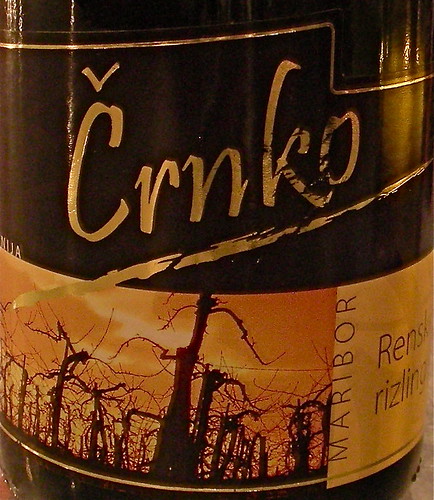 • 2007 Crnko Renski Rizling: located a few miles from the city of Maribor in the Podravje region, the Crnko winery is a small estate of only five and a half hectares spread over two vineyards. The wine is 100% Riesling. My notes: floral nose with a touch of petrol; on the palate, dry to medium dry, fresh, light, and lively, low in alcohol (10%). The wine should go well with a light Crab Salad
• 2007 Crnko Renski Rizling: located a few miles from the city of Maribor in the Podravje region, the Crnko winery is a small estate of only five and a half hectares spread over two vineyards. The wine is 100% Riesling. My notes: floral nose with a touch of petrol; on the palate, dry to medium dry, fresh, light, and lively, low in alcohol (10%). The wine should go well with a light Crab Salad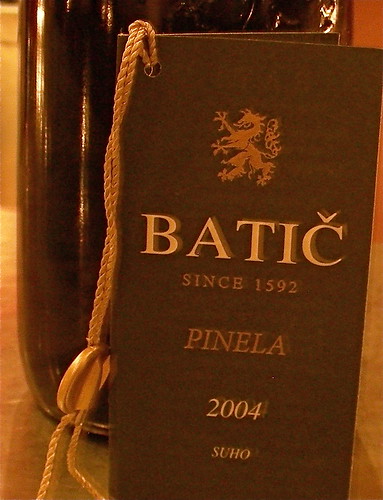 • 2004 Batic Pinela: Batic is a family-run farm and winery located in the Vipava valley, only 15 miles from the Italian border. The winery takes an organic approach to wine production. Pinela is a rare white variety native to the Primorje region. My notes: aged in barrique, fragrant nose of exotic fruit, pineapple; on the palate, medium to full-bodied, slightly oily mouthfeel, distinctive, more alcohol than the Riesling (14%).
• 2004 Batic Pinela: Batic is a family-run farm and winery located in the Vipava valley, only 15 miles from the Italian border. The winery takes an organic approach to wine production. Pinela is a rare white variety native to the Primorje region. My notes: aged in barrique, fragrant nose of exotic fruit, pineapple; on the palate, medium to full-bodied, slightly oily mouthfeel, distinctive, more alcohol than the Riesling (14%).  • 2006 Santomas Big Red: The Santomas winery sits on a hillside overlooking the Adriatic Sea, just southeast of Trieste. Taking full advantage of the warm Mediterranean climate, the winery specializes in red wines. The wine is made from the Refosk grape, also known as Refosco, a varietal native to the northern Italian areas of Friuli, Gavi, and Trentino. My notes: lots of fruit on the nose with notes of vanilla, round on the palate, well-structured, good acidity, slightly rustic. Should work well with a tomato and mushroom dish like this Pasta with Sausage, Tomatoes, and Mushrooms dish.
• 2006 Santomas Big Red: The Santomas winery sits on a hillside overlooking the Adriatic Sea, just southeast of Trieste. Taking full advantage of the warm Mediterranean climate, the winery specializes in red wines. The wine is made from the Refosk grape, also known as Refosco, a varietal native to the northern Italian areas of Friuli, Gavi, and Trentino. My notes: lots of fruit on the nose with notes of vanilla, round on the palate, well-structured, good acidity, slightly rustic. Should work well with a tomato and mushroom dish like this Pasta with Sausage, Tomatoes, and Mushrooms dish.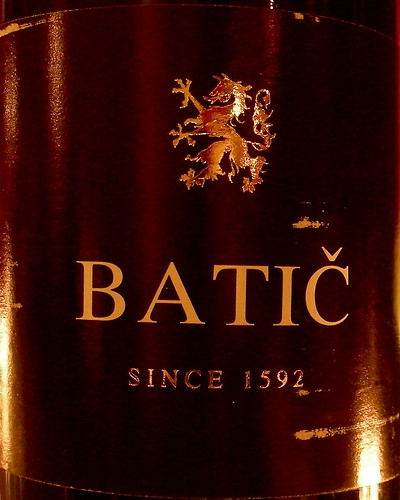 • 2006 Batic Cabernet Franc: another organically grown wine from the Batic winery of Vipava Valley. The wine was fermented using native yeast and was aged 12 months in Slovenian oak barrels and another six months in the bottle. My notes: black fruits on the nose, full-bodied on the palate with firm tannins, still young but tasty. Try it with Grilled Marinated Steaks.
• 2006 Batic Cabernet Franc: another organically grown wine from the Batic winery of Vipava Valley. The wine was fermented using native yeast and was aged 12 months in Slovenian oak barrels and another six months in the bottle. My notes: black fruits on the nose, full-bodied on the palate with firm tannins, still young but tasty. Try it with Grilled Marinated Steaks.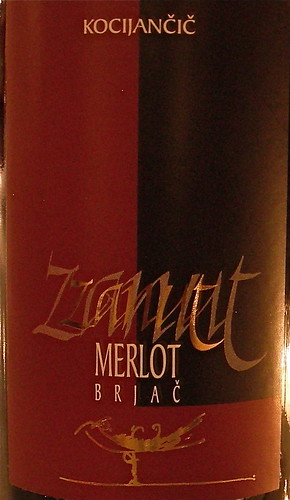 • 1999 Kocijancic-Zanut Merlot Brjac: Kmetija Kocijancic-Zanut is a winery located in the Brda appellation, which means hills in Slovene. This is a region of rounded hills in the western part of the country bordering Italy. The wine was aged 4 months in stainless steel tanks, then transferred to French oak barrels for 4 years, and then aged in the bottle for an additional six months. My notes: nose of black fruit with gamey flavors, rather smooth on the palate, long finish. It's a wine that calls for venison dishes, like this Slovenian Venison Stew.
• 1999 Kocijancic-Zanut Merlot Brjac: Kmetija Kocijancic-Zanut is a winery located in the Brda appellation, which means hills in Slovene. This is a region of rounded hills in the western part of the country bordering Italy. The wine was aged 4 months in stainless steel tanks, then transferred to French oak barrels for 4 years, and then aged in the bottle for an additional six months. My notes: nose of black fruit with gamey flavors, rather smooth on the palate, long finish. It's a wine that calls for venison dishes, like this Slovenian Venison Stew. • 2001 Graben Gamay: Vino Graben is a winery located in the Bizeljsko-Sremic district of the Posavje wine region. It lies on the northern bank of the Sava River, close to the Croatian border. Gamay is a grape that have been introduced to Slovenia from France and is not widely used in the country. Vino Graben makes some Gamay with microproduction quantities. My notes: flavors reminiscent of rose water flavored marshmallow, light bodied and rather dry on the palate, very unusual.
• 2001 Graben Gamay: Vino Graben is a winery located in the Bizeljsko-Sremic district of the Posavje wine region. It lies on the northern bank of the Sava River, close to the Croatian border. Gamay is a grape that have been introduced to Slovenia from France and is not widely used in the country. Vino Graben makes some Gamay with microproduction quantities. My notes: flavors reminiscent of rose water flavored marshmallow, light bodied and rather dry on the palate, very unusual.What an enlightening tasting and a wonderful evening! And if you're in the area, don't miss A Slovenian Wine Extravaganza at CAV Wine Bar & Kitchen this Saturday, January 17.
Related post:
• Wines of Germany and Eastern Europe class: Croatia, Slovenia and Romania
Technorati tags: wine food & drink
No comments:
Post a Comment